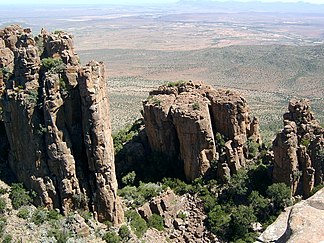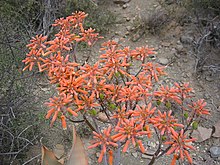Sneeuberg
| Sneeuberg | ||
|---|---|---|
|
On the southern slope of the Sneeuberg massif in Camdeboo National Park |
||
| Highest peak | Kompasberg ( 2504 m ) | |
| location | Eastern Cape , Western Cape and Northern Cape Provinces ( South Africa ) | |
|
|
||
| Coordinates | 31 ° 47 ′ S , 24 ° 39 ′ E | |
The Sneeuberg , also Sneeuberge ( English Snow Mountains ), called mountain group is an extensive South African mountain range in the provinces of Eastern Cape , Western Cape and Northern Cape . This mountain landscape belongs to the arid and semi-arid areas in southwest South Africa ( Karoo in the broader sense). The Sneeuberg massif forms an important part of the Great Escarpment (Great Escarpment) in South Africa.
expansion
In the north, west and south the mountain range merges into the undulating land of the Karoo steppe. To the east, the Sneeuberg elevations drop into the Great Fish River Basin ( Fish River Basin ). The Bankberg massif connects to the southeast via a saddle and the Camdeboo plains continue in front of the mountains to the south. The Nelspoort zone connects to the west .
Traffic development
A railway line and the N9 national road run through the Sneeuberg Mountains . Both connect the cities of Graaff-Reinet and Middelburg .
The regional road R63 leads from Graaff-Reinet in a westerly direction over two passes to Murraysburg in the Western Cape. From the small traffic junction Betheshdaweg you can get to Cradock on the regional road R61 over the eastern foothills .
Road traffic overcomes several passes. These are the:
- Lootsberg Pass (1789 meters)
- Naudeberg Pass (1400 meters)
- Wapadsberg pass (1700 meters) (passing the Bankberg massif)
- Goliatskraal se Hoogte
- Ouberg pass on the R63, junction to Nieu Bethesda
colonization
The most important settlements are on the edge and thus in the lower water-rich layers of the Sneeuberg region. These include the towns of Murraysburg, Nieu Bethesda , Bethesdaweg and Heydon . Graaff-Reinet and Middelburg are located in the upstream levels.
vegetation
The Sneeuberg massif is characterized in many areas by landscapes with little vegetation. The semi-arid climate of the Karoo allows only sparse vegetation. Large areas are covered with semi-desert scree fields, in which isolated low shrub plants (so-called shrub karoo ) appear. Grass savannahs can be found in more humid regions, and trees are also found in water-rich canyons. The vegetation-rich areas of the mountains can be found in its eastern and southern parts. Investigations revealed 1195 plant species.
Geology, structure, water
The geological conditions and the water situation are particularly decisive for the use of the Sneeuberg as farmland . The latter, favored by the prevailing climatic conditions, led to an anthropogenic change in the soil and the water balance.
Geological conditions
Geologically, the Sneeuberg massif belongs to the main Karoo basin . It consists of sedimentary rocks of the Beaufort group . Typical rocks are sandstones and mudstones . The dolerite intrusions typical of the Karoo system in the form of dykes and sills penetrate the sediment units in numerous places .
structure
Individual areas of the Sneeuberge have their own names. To the south are the Koueveld Mountains (2,388 meters) and the Kamdeboo Mountains (1,804 meters).
At 2,504 meters, the Kompasberg is the highest point in the mountain range. It was named in 1778 by Colonel Robert Jacob Gordon during a reconnaissance trip with Governor Joachim van Plettenberg to the borders of the Cape Colony at that time .
The plateaus in the mountains are at altitudes between 1800 and 2100 meters.
Hydrological conditions
The drainage of the mountains takes place to the north in the system of the Oranje towards the Atlantic Ocean . These include the Seacow River and some of its tributaries.
In an easterly direction, the Kleinbrakrivier brings the water into the Great Fish River . To the south, the surface water is mainly discharged via the Sundays River . The Kariega River, which runs along the western edge of the mountains, drains over the Groot River and further below the Gamtoos River into the Indian Ocean .
One problem is the entry of sediments into the watercourses caused by soil erosion . The gravel, sand and silt carried along lead to a permanent burden on water management systems and to losses of usable land. In some places such sediment fillings have been used to study their chronological sequence of formation.
The problem of erosion is associated with erosion channels (gullies) that cut deep into the terrain and lead to changes in natural vegetation over a large area. The erosion and changes in the soil were mapped several times for the purpose of their research. Regarding the formation of erosion channels in the Sneeuberge, one already deduces a period before 1940, when a period of heavy rain affected the soil, which was heavily used by livestock farming.
Dams
The Nqweba Dam (formerly Van Ryneveldspass dam ) near Graaff-Reinet and a dam on the Seacow River on the northern slope of the mountain south-east of Richmond are among the larger reservoirs . Numerous smaller water reservoirs were created in the valleys of the northern mountain slopes. Many of them serve to irrigate a neighboring farm in this barren landscape.
Economic activities
Due to the natural foundations, agricultural activities are only possible to a limited extent. The Strauchkaroo enables extensive livestock farming, which only offers a few people an income basis. Wool sheep is raised in the region and mohair is produced to a limited extent . Up to 1,600 meters above sea level, moist valleys are used as pastures for the sheep herds. Farms used to grow wheat here.
A national park near Graaff-Reinet and the scenic situation allow some jobs in the field of outdoor tourism.
Attractions
- The Owl House is a museum commemorating the inspirational work of the mystic Helen Martins . The museum was established in 1980.
- The Camdeboo National Park is located on the southern foothills
- The Valley of Desolation ( Valley of Desolation ) stands out with its bizarre rock formations with steep walls.
Miscellaneous
The scientific name of a plant from the balloon pea genus is associated with the name of this mountain range . It is the species Lessertia sneeuwbergensis Germish.
literature
- VR Clark, NP Barker, L. Mucina: The Sneeuberg: A new center of floristic endemism on the Great Escarpment, South Africa. In: South African Journal of Botany. Volume 75, Issue 2, 2009, pp. 196–238.
- Ernst Klimm, Karl-Günther Schneider, Bernd Weise: Southern Africa. Part 1: Republic of South Africa, Swaziland, Lesotho. (= Scientific regional customers. Volume 17). Knowledge Buchgesellschaft, Darmstadt 1980, ISBN 3-534-04132-1 .
- Mike Raath, Dorothy Pitman, Jenny Bennie: Museums of the Eastern Cape . Port Elizabeth (SAMA Eastern Cape) 1996, ISBN 0-620-19916-4 .
Individual evidence
- ^ VR Clark, NP Barker, L. Mucina: The Sneeuberg: A new center of floristic endemism on the Great Escarpment, South Africa. In: South African Journal of Botany. Vol 75, No. 2, April 2009, pp. 196-238. doi: 10.1016 / j.sajb.2008.10.010
- ^ John Boardman et al.: Land Degradation in the Karoo, South Africa. ( Memento of the original from October 27, 2009 in the Internet Archive ) Info: The archive link was inserted automatically and has not yet been checked. Please check the original and archive link according to the instructions and then remove this notice. Retrieved November 17, 2009.
- ^ J. Keay-Bright, J. Boardman, The influence of land management on soil erosion in the Sneeuberg Mountains, Central Karoo, South Africa. In: Land Degradation & Development. Volume 18, Issue 4, pp. 423–439.
- ^ William Beinart: The Rise of Conservation in South Africa: Settlers, Livestock, and the Environment 1770-1950 . Oxford University Press, Oxford 2008, ISBN 978-0-19-954122-5 , pp. 378 (English, limited preview in Google Book search).
- ↑ Entry at www.tropicos.org , accessed on January 18, 2016.
Web links
- Geography and geology of the area around Nieu-Bethesda (English text)
- Brief description of Camdeboo National Park
- Image from Kompasberg at panoramio
- University of Oxford, Environmental Change Institute: Land Degradation in the Karoo, South Africa (English text)
- Graaff-Reinet and the Second Anglo-Boer War (1899–1902) - War history of the region (English text)
- Murraysburg website (English text)





